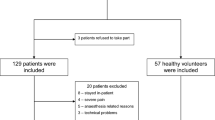Abstract
Objective. In a previous study of patients emerging from anesthesia following surgery, we found that a brief wakeful response to command of an eye opening or single hand squeeze or count was not associated with memory formation, while the response of four hand squeezes or counts was associated with memory. We wanted to determine the anesthetic requirements for obtaining this brief wakeful response endpoint during surgery and to determine if memory occurred at this endpoint during surgical anesthesia.Methods. Six different combinations of isoflurane, 70% N2O, and fentanyl were administered to 326 patients undergoing pelvic laparoscopy. After insertion of the trocar, anesthesia was reduced while patients were given verbal commands, and they were observed for movement responses to surgery and to command. Patients were classified as either not arousing, arousing with a movement response to surgery, or arousing with a wakeful response to command. For the patients who aroused, we calculated the percentage of arousal responses that were wakeful responses to command. The effect of fentanyl dosage upon the percentage of arousal responses that were wakeful responses to command was determined by using a Mann-Whitney test to compare a group of patients receiving fentanyl 2 µg/kg or less, with a group receiving fentanyl 4 µg/kg. In a subset of 39 patients, the potential for memory formation was evaluated by presenting a target sound to 29 patients during a period of either no arousal, movement response to surgery, or wakeful response to command; for a control group of 10 patients, no target sound was presented. All 39 patients were tested for memory of the target sound; the results from each group receiving a target sound were compared with the results of the control group, using a Mann-Whitney test.Main Results. A total of 68 patients aroused with either a movement response or a wakeful response to command. Wakeful responses occurred with only 1 of 39 patients (3%) receiving fentanyl 2 µg/kg or less; but, wakeful responses occurred with 17 of 29 patients (59%) receiving fentanyl 4 µg/kg. The difference between the groups was significant atp=0.01. None of the 68 patients had recall of intraoperative events or unpleasant dreams. None of these patients who were in the multiple-choice memory subset recalled the target sound. There were no statistically significant differences on the multiple-choice memory test between the groups presented with the target sound and the control group. Patient anecdotes suggested that some patients may have had memory of the target sound; but, memory was no more likely in patients with a brief wakeful response to command than in those who responded with a movement to surgical stimulation or those who did not have an arousal response.Conclusions. A brief wakeful response to a command of opening the eyes or squeezing the hand was not associated with increased memory formation during surgery. A brief wakeful response to command was found during surgery when patients received fentanyl 4 µg/kg; but it was rarely found at fentanyl dosages of 2 µg/kg or less.
Similar content being viewed by others
References
Dutton RC, Smith WD, Smith NT. Wakeful response to command indicates memory potential during emergence from general anesthesia. J Clin Monit 1995;11:35–40
Artusio JF. Di-ethyl ether analgesia: A detailed description of the first stage of ether anesthesia in man. J Pharmacol Exp Ther 1954;111:343–348
Millar K, Watkinson N. Recognition of words presented during general anaesthesia. Ergonomics 1983;26:585–594
Bogod DG, Orton JK, Yau HM, Oh TE. Detecting awareness during general anaesthetic caesarean section. Anaesthesia 1990;45:279–284
Breckenridge F, Aitkenhead AR. Isolated forearm technique for detection of wakefulness during general anaesthesia. Br J Anaesth 1981;53:665P-666P
Ghoneim MM, Block RI. Learning and consciousness during general anesthesia. Anesthesiology 1992;76:279–305
Russell IF. Balanced anesthesia: Does it anesthetize? Anesth Analg 1985;64:941–944
Russell IF. Comparison of wakefulness with two anaesthetic regimens, total IV v balanced anaesthesia. Br J Anaesth 1986;58:965–968
Stoelting RK, Longnecker DE, Eger EI II. Minimum alveolar concentrations in man on awakening from methoxyflurane, halothane, ether, and fluroxene anesthesia: MAC Awake. Anesthesiology 1970;33:5–9
Tunstall ME. Detecting wakefulness during general anaesthesia for caesarean section. Br Med J 1977;1:1321
Tunstall ME. The reduction of amnesic wakefulness during caesarean section. Anaesthesia 1979;34:316–319
Palahniuk RJ, Shnider SM, Eger EI II. Pregnancy decreases the requirement for inhaled anesthetic agents. Anesthesiology 1974;41:82–83
Russell IF. Auditory perception under anaesthesia. Anaesthesia 1979;34:211
Schultetus RR, Hill CR, Dharamraj CM, et al. Wakefulness during caesarean section after anesthetic induction with ketamine, thiopental, or ketamine and thiopental combined. Anesth Analg 1986;65:723–728
Author information
Authors and Affiliations
Rights and permissions
About this article
Cite this article
Dutton, R.C., Smith, W.D. & Smith, N.T. Brief wakeful response to command indicates wakefulness with suppression of memory formation during surgical anesthesia. J Clin Monitor Comput 11, 41–46 (1995). https://doi.org/10.1007/BF01627419
Received:
Revised:
Accepted:
Issue Date:
DOI: https://doi.org/10.1007/BF01627419




